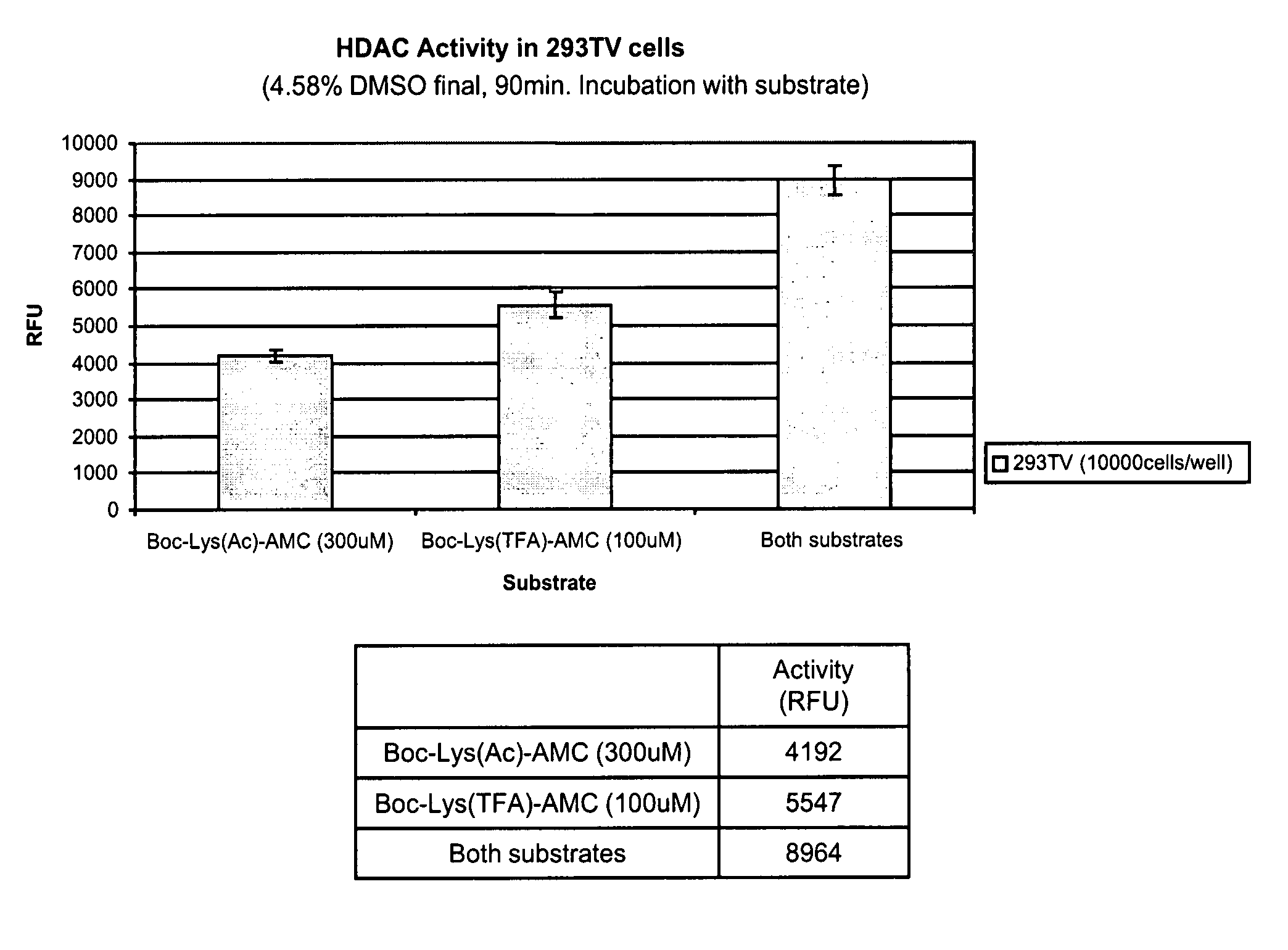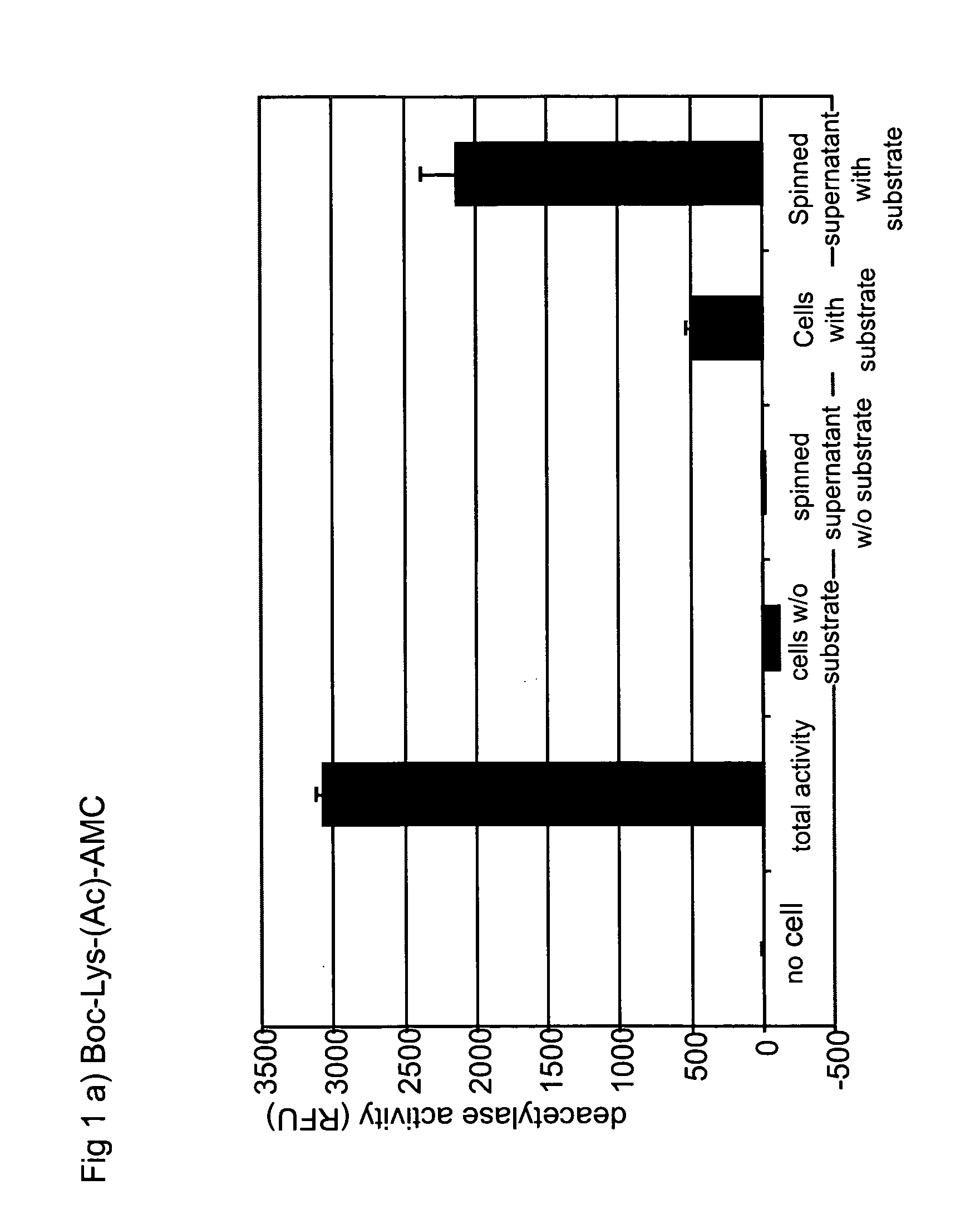Class ii histone deacetylase whole cell enzyme assay
- Summary
- Abstract
- Description
- Claims
- Application Information
AI Technical Summary
Benefits of technology
Problems solved by technology
Method used
Image
Examples
example 1
Intracellular and Excellular Deacetylase Activity of Human 293T Cells Using Boc-Lys(Ac)-AMC as Substrate
[0157]Freshly trypsinized cells (293T) were dispensed into 96-well black Costar E1A / RIA plates (Corning Inc., Corning, N.Y.). Small molecule substrate Boc-Lys(Ac)-AMC (Bachem Biosciences Inc., King of Prussia, Philadelphia) were added to cell suspension with the final concentration of 300 uM. Cells were placed in 37° C. incubator with 5% CO2 for indicated time period. Supernatant was collected if necessary and subject to spinning. Reaction was stopped by adding a freshly prepared Fluor-de-Lys™ developer (Biomol, Plymouth Meeting, Philadelphia) with 1 uM TSA (Biomol, Plymouth Meeting, Philadelphia) in assay buffer (25 mM Tris, HCl pH8.0, 137 mM NaCl, 2.7 mM KCl, 1 mM MgCl2) plus 1% NP-40 into supernatant or cell pellets. Fluorescence was developed for 15 minutes at 37° C. and read in a fluorometer (SPECTRAMAX GeminiXS, Molecular Devices, Sunnylvale, Calif.) with an excitation wavel...
example 2
Whole Cell Activity in Human Cancer Cells and Normal Cells Using Boc-Lys(Ac)-AMC
[0158]Freshly trypsinized cells were dispensed into 96-well black Costar E1A / RIA plates (Corning Inc., Corning, N.Y.). Small molecule substrate Boc-Lys(Ac)-AMC (Bachem Biosciences Inc., King of Prussia, Philadelphia) was added to cell suspension with the final concentration of 300 uM. Cells were placed in 37° C. incubator with 5% CO2 for 90 minutes. Reaction was stopped by adding a freshly prepared Flouor-de-Lys™ deleveloper (Biomol, Plymouth Meeting, Philadelphia) with 1 uM TSA (Biomol) in assay buffer (25 mM Tris, HCl pH8.0, 137 mM NaCl, 2.7 mM KCl, 1 mM MgCl2) plus 1% NP-40. With the presence of 1% NP-40, both excellular and intracellular HDAC activity was measured in cultured cells altogether. Fluorescence was developed for 15 minutes at 37 C and read in a fluorometer (SPECTRAMAX GeminiXS, Molecular Devices, Sunnylvale, Calif.) with an excitation wavelength at 360 nm, emission at 470 nm, and a cutoff...
example 3
Effect of Boc-LysAc-AMC Substrate Concentration on Deacetylase Activity in Human Cancer Cell Lines
[0159]Cells were trypsinized and counted by trypan blue exclusion. Live cells (4×104 A549 cells, or 1×105 HCT116 cells, or 5×104 Du145 cells) were distributed to each well of the 96-well plate. HDAC small molecule substrate Boc-Lys(Ac)-AMC with a range of final concentrations was added into cell suspensions and incubated with cells for 90 minutes at 37 C before reaction was stopped, and fluorescence was developed and read. As shown in FIG. 4, effect of substrate concentration on whole cell deacetylase activity was measured. Km of Boc-Lys(Ac)-AMC ranged from 150 μM to 220 μM.
PUM
 Login to View More
Login to View More Abstract
Description
Claims
Application Information
 Login to View More
Login to View More - R&D
- Intellectual Property
- Life Sciences
- Materials
- Tech Scout
- Unparalleled Data Quality
- Higher Quality Content
- 60% Fewer Hallucinations
Browse by: Latest US Patents, China's latest patents, Technical Efficacy Thesaurus, Application Domain, Technology Topic, Popular Technical Reports.
© 2025 PatSnap. All rights reserved.Legal|Privacy policy|Modern Slavery Act Transparency Statement|Sitemap|About US| Contact US: help@patsnap.com



